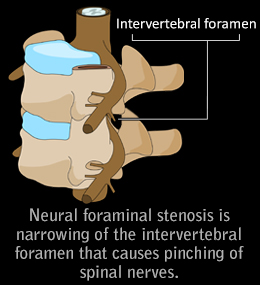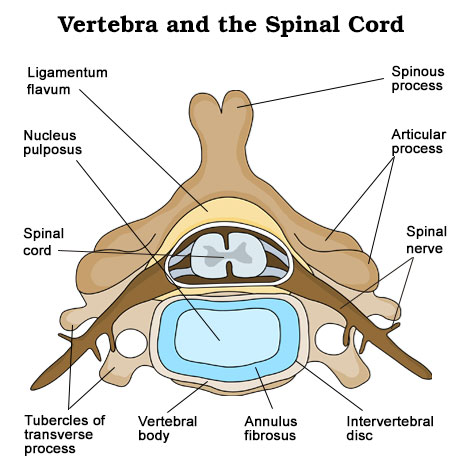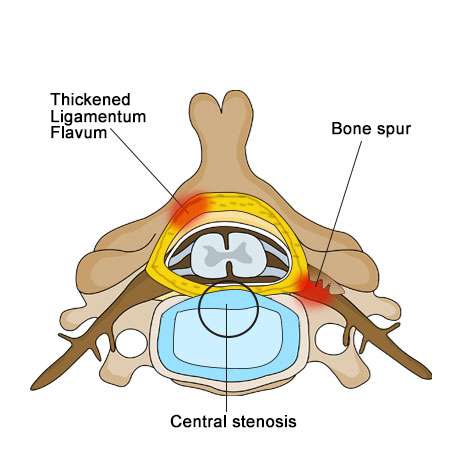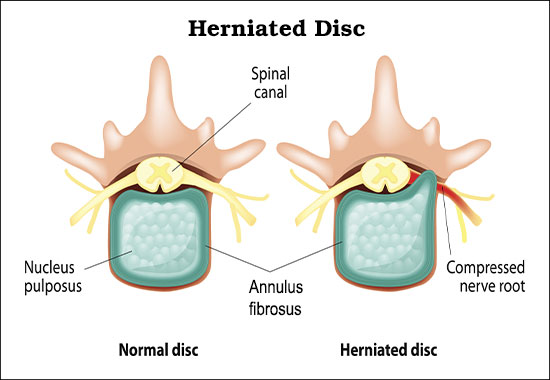Neural foraminal stenosis is a medical condition wherein the intervertebral foramina, which are openings on the sides of the vertebrae through which the spinal nerves exit the spinal column, become narrow. This Buzzle write-up provides information on the various causes of neural foraminal stenosis.

Did You Know?With a width of 6.4 - 13 mm, and length of 43 - 45 cm, the human spinal cord weighs about 35 g and is composed of a whopping 13,500,000 neurons.The human spine, which is also referred to as the vertebral column, supports the spinal cord. The vertebral column comprises 33 vertebrae (7 cervical, 12 thoracic, 5 lumbar, 5 sacral, and 4 coccygeal). The cervical, thoracic, and lumbar vertebrae are separated by the intervertebral discs. The spinal cord is shorter than the vertebral column, which is about 70 cm long. At the second lumbar vertebra, the spinal cord terminates into filum terminale, which refer to strands of fibrous tissue. A pair of spinal nerves leave each segment of the spinal cord. Thus, there are 31 pairs of spinal nerves that emerge through the neuroforamen or intervertebral foramen (an opening located between the adjacent vertebrae). However, the first pair of spinal nerve is an exception, as it emerges between the occipital bone and the atlas.
The spinal nerves perform the function of carrying motor, sensory, and autonomic signals between the spinal cord and the rest of the body. Foraminal stenosis is mostly a degenerative condition of the spine wherein the narrowing of the foramen can cause a host of symptoms. This condition can be bilateral, which means that both the right and left neuroforamen are affected.
Symptoms of Neural Foraminal Stenosis

Under normal circumstances, the intervertebral foramina have ample space for the nerves to pass through. However, with age, the foramina could get constricted due to accumulation of debris, which in turn would cause the nerves to get compressed. When the foramen becomes narrow and presses against the spinal cord and/or spinal nerves, it could give rise to symptoms that might be similar to the ones caused by other spinal conditions.
Symptoms could also vary, depending on the area of the spine affected. The most common symptoms include:
✦ Pain that could be dull, sharp, or radiating
✦ Weakness or numbness in the extremities
✦ Burning sensation
✦ Pins and needles sensation
✦ Difficulty walking or standing straight
If the foramina in the cervical spine are affected, one is likely to experience pain (numbing/sharp/burning/tingling) in the neck and/or shoulders, and the pain might even radiate to the arms, hands, and fingers. In case of foraminal stenosis in the lumbar area, pain would be felt in the lower back, and it is likely to radiate to the buttocks, legs, feet, and toes.
Contributing Factors
Conditions like bone spurs, thickened ligamentum flavum and bulging discs are common causes of intervertebral foraminal stenosis. (Check the illustration below)

✦ Bone spurs
Osteophytes, which are referred to as bone spurs, are bony projections that could form along the edges of the joints. If an osteophyte develops around or on the foramina, it could constrict the opening through which the spinal nerves exit the spinal column. This could cause the compression of spinal nerve, which might lead to pain and other symptoms. More often than not, such a degeneneration of spine could be age-related.
✦ Thickened Ligamentum Flavum
Another age-related degenerative change of the spine is the enlargement or calcification of ligaments of the spine. Ligaments are elastic bands of tissue that support the spine and prevent the vertebrae from slipping out of line, as the spine moves. Ligamentum flavum is a large band of tissue that runs between the lamina (the part of the vertebra at the back of the vertebral arch that forms the roof of the canal through which the spinal cord and nerve roots pass) from the second vertebra to the sacrum in the spine. The ossification (accumulation of calcium deposits) on this ligament, as well as the posterior longitudinal ligament that is situated between the vertebral canal, can cause the narrowing of the vertebral foramen or the intervertebral foramen, which can cause compression of the spinal nerve roots and lead to pain.
✦ Spondylolisthesis
Arthritic changes in the joints of the vertebrae can also lead to malalignment of vertebrae or spondylolisthesis. This condition is said to occur when one of the vertebrae slips forward or backward on to the next vertebra. When the vertebra slips forward on a lower vertebra, the condition is called anterolisthesis. The backward slippage of the upper vertebra on to the lower vertebra is referred to as retrolisthesis. Besides causing the spine to become deformed, spondylolisthesis can cause narrowing of the spinal canal (central spinal stenosis) or compression of the nerve roots exiting through the intervertebral foramen (central foraminal stenosis). Degenerative bone disease, trauma, or stress injuries could be the contributing factors.
✦ Herniated/Bulging Disc

As mentioned earlier, the vertebrae are separated by intervertebral discs that have a hard outer covering called annulus fibrosus and a soft, jelly-like interior called nucleus pulposus. At times, injury or age-related degeneration of the spine can cause the intervertebral disc to bulge out from its place. On the other hand, a herniated disc is a condition wherein the annulus or the hard exterior of the disc weakens and ruptures, thereby causing the jelly-like material from the interior to leak out. The bulge could also narrow the foramen. Pain is often experienced when the bulge causes the spinal nerves to get compressed.
✦ Arthritis of the Spine
Osteoarthritis is a degenerative process that is characterized by the wear and tear of the cartilage that lines the ends of the joints. It might lead to bone overgrowth or the formation of bone spurs. The joints in the spine are referred to as the facet joints. Spinal arthritis that is characterized by the inflammation of the facet joints of the vertebral column could also be a contributing factor for the narrowing of the foramen. Arthritis could also affect the intervertebral discs. Degenerative disc disease or enlargement or overgrowth of bone can narrow the spinal canal or the intervertebral foramen which might lead to spinal stenosis or neural foraminal stenosis, respectively.
✦ Other Causes
In some cases, the dimensions of the spinal canal, as well as the intervertebral foramen might change due to scoliosis, a condition that is characterized by abnormal curvature of the spine. Due to the abnormal curvature, there might be pressure on the soft tissue and nerves, and the ligaments might get compressed or stretched. The diameter of the spinal canals can also reduce in case of short and thickened pedicles (narrow stem-like structures on the vertebrae that form the walls of the front part of the vertebral arch) that are observed in individuals affected by an inherited condition called achondroplasia. The development of tumors on the spine or other structural abnormalities could also lead to stenosis.
On a concluding note, stenosis of the vertebral and intervertebral foramen is often associated with age-related degenerative changes of the spine. Thus, to treat the neural foraminal narrowing, the underlying cause has to be identified and treated. This condition can be diagnosed with the help of medical history, physical examination, and imaging tests such as an X-ray of the spine, MRI, Computerized axial tomography (CAT) scan, myelogram, and bone scans. As far as the treatment is concerned, the conservative treatment involves the use of NSAIDs, analgesics, corticosteroid injections, nerve blocks, lifestyle modification, etc. The affected individuals need to avoid strenuous physical activities that can put pressure on the spine. Physical therapy can also prove to be beneficial. Surgery might be considered in case of severe neural foraminal stenosis, when conservative treatment options have not helped.
Disclaimer:
The information provided in this article is solely for educating the reader. It is not intended to be a substitute for the advice of a medical expert.


 Did You Know?With a width of 6.4 - 13 mm, and length of 43 - 45 cm, the human spinal cord weighs about 35 g and is composed of a whopping 13,500,000 neurons.The human spine, which is also referred to as the vertebral column, supports the spinal cord. The vertebral column comprises 33 vertebrae (7 cervical, 12 thoracic, 5 lumbar, 5 sacral, and 4 coccygeal). The cervical, thoracic, and lumbar vertebrae are separated by the intervertebral discs. The spinal cord is shorter than the vertebral column, which is about 70 cm long. At the second lumbar vertebra, the spinal cord terminates into filum terminale, which refer to strands of fibrous tissue. A pair of spinal nerves leave each segment of the spinal cord. Thus, there are 31 pairs of spinal nerves that emerge through the neuroforamen or intervertebral foramen (an opening located between the adjacent vertebrae). However, the first pair of spinal nerve is an exception, as it emerges between the occipital bone and the atlas.
Did You Know?With a width of 6.4 - 13 mm, and length of 43 - 45 cm, the human spinal cord weighs about 35 g and is composed of a whopping 13,500,000 neurons.The human spine, which is also referred to as the vertebral column, supports the spinal cord. The vertebral column comprises 33 vertebrae (7 cervical, 12 thoracic, 5 lumbar, 5 sacral, and 4 coccygeal). The cervical, thoracic, and lumbar vertebrae are separated by the intervertebral discs. The spinal cord is shorter than the vertebral column, which is about 70 cm long. At the second lumbar vertebra, the spinal cord terminates into filum terminale, which refer to strands of fibrous tissue. A pair of spinal nerves leave each segment of the spinal cord. Thus, there are 31 pairs of spinal nerves that emerge through the neuroforamen or intervertebral foramen (an opening located between the adjacent vertebrae). However, the first pair of spinal nerve is an exception, as it emerges between the occipital bone and the atlas.

